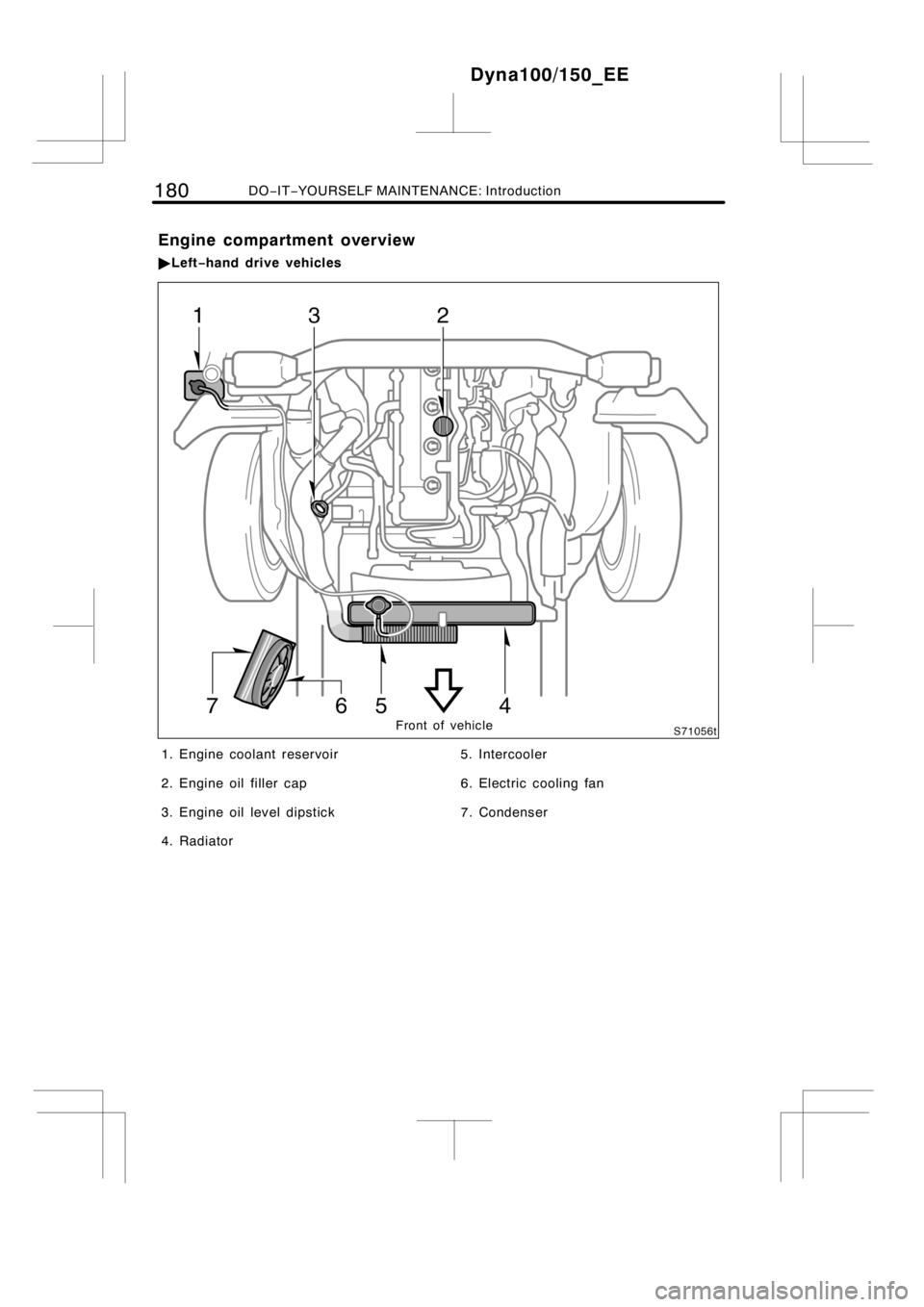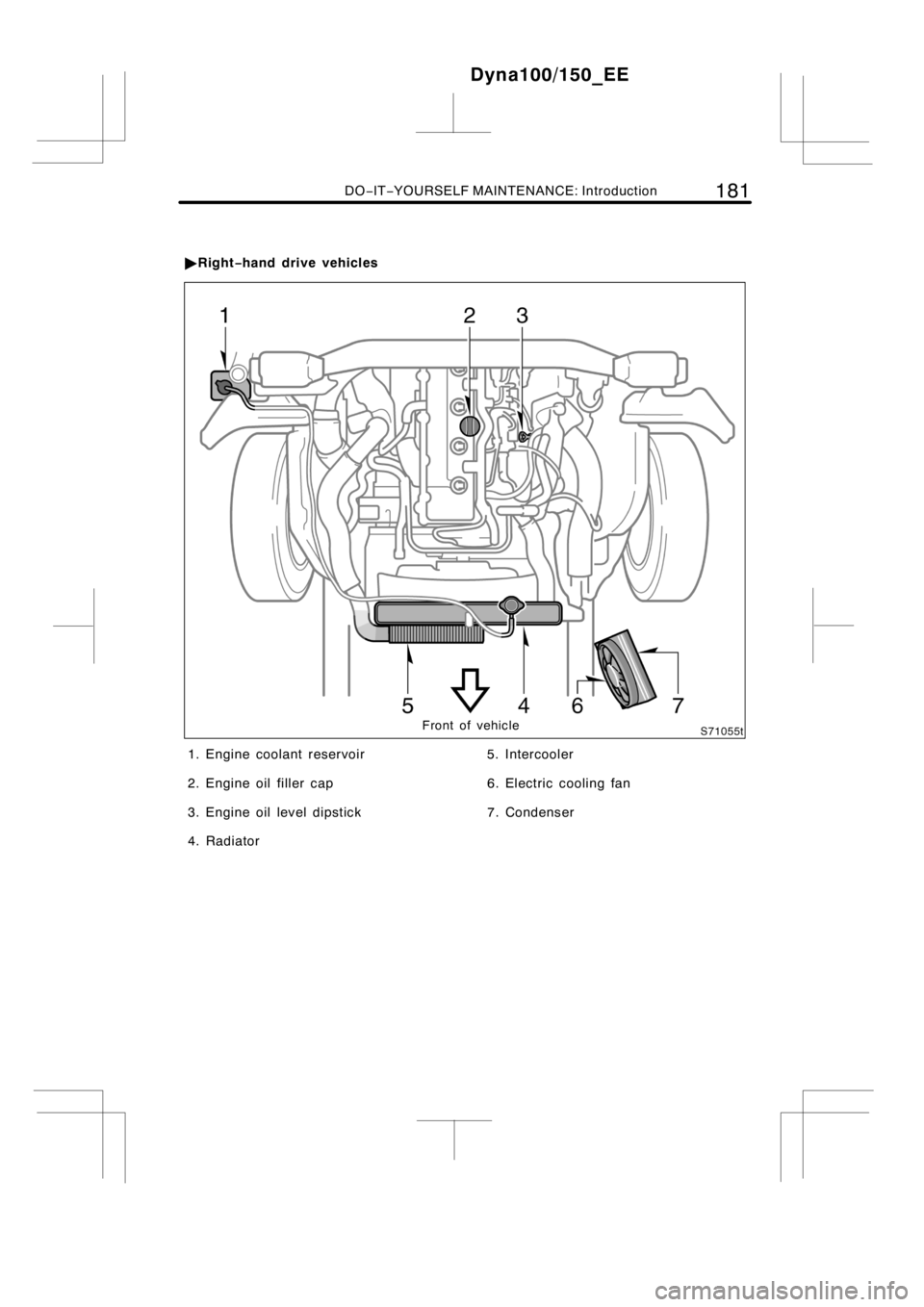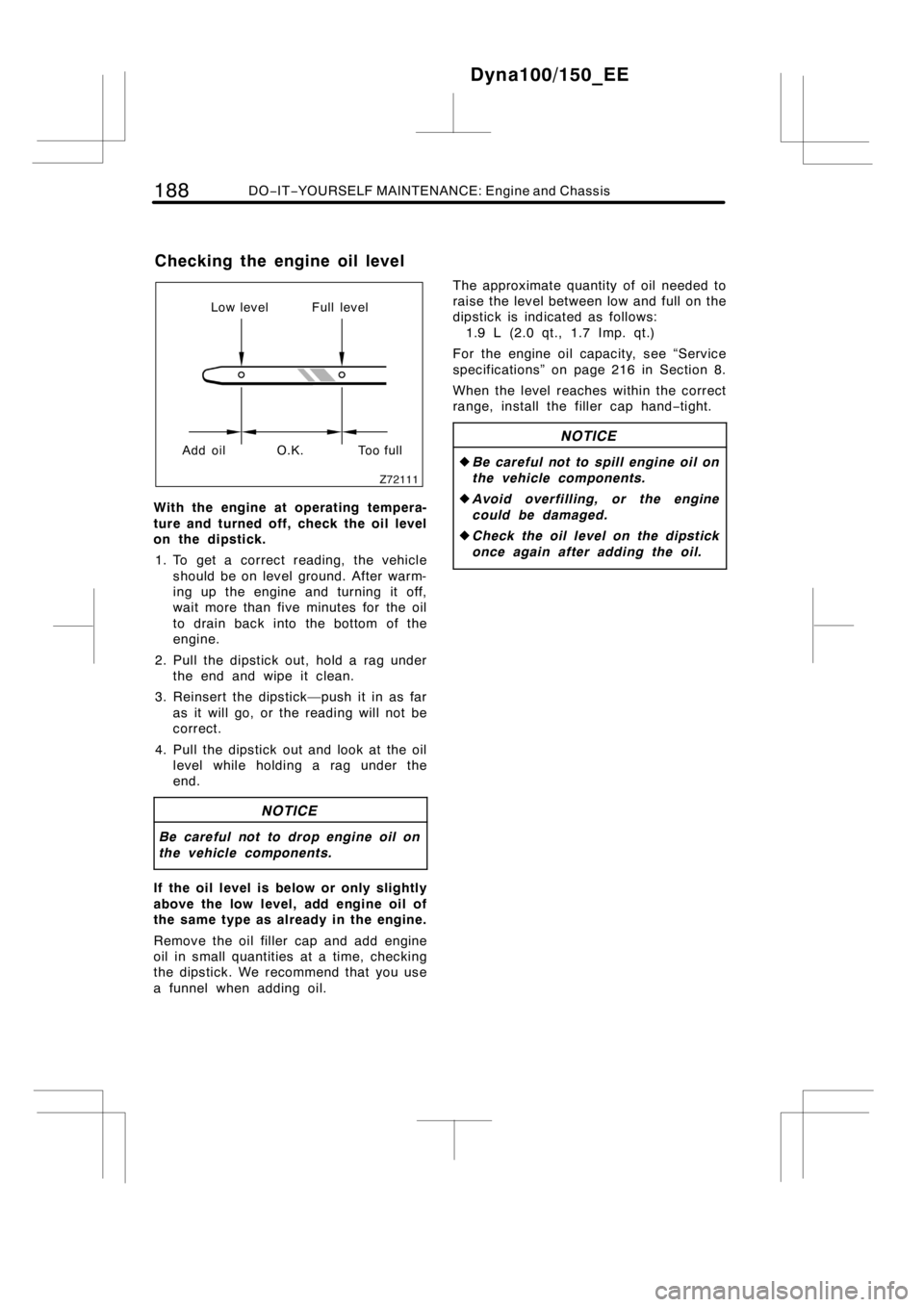2014 TOYOTA DYNA 100/150 oil level
[x] Cancel search: oil levelPage 133 of 232

STARTING AND DRIVING127
Instruments and controls.Especially
make sure the service reminder indicators,
instrument lights, and defroster are work-
ing.
Brakes.Make sure the pedal has enough
clearance.
Spare fuses.Make sure you have spare
fuses. They should cover all the amperage
ratings designated on the fuse box lid.
In the engine compartment
Coolant level.Make sure the coolant lev-
el is correct. (See page 190 in Section
7−2 for instructions.)
Wiring.Look for damaged, loose, or dis-
connected wires.
Fuel lines.Check the lines for leaks or
loose connections.
AFTER STARTING THE ENGINE
Exhaust system.If you notice any
change in the sound of the exhaust or
smell exhaust fumes, have the cause lo-
cated and corrected immediately. (See
“Engine exhaust cautions” on page 114 in
Section 2.)
Engine oil level.Stop the engine and
check the dipstick with the vehicle parked
on a level spot. (See page 188 in Section
7−2 for instructions.)
WHILE DRIVING
Instruments.Make sure the speedometer
and gauges are working.
Brakes.In a safe place, check that the
brakes do not pull to one side when ap-
plied.
Anything unusual?Look for loose parts
and leaks. Listen for abnormal noises.
If everything looks O.K., set your mind at
ease and enjoy your trip!DAlways slow down in gusty crosswinds.
This will allow you much better control.
DDrive slowly onto curbs and, if pos-
sible, at a right angle. Avoid driving
onto high, sharp−edged objects and
other road hazards. Failure to do so
can lead to severe tire damage such
as a tire burst.
Drive slowly when passing over bumps
or travelling on abumpy road. Other-
wise, the impact could cause severe
damage to the tires and/or wheels.
DWhen parking on a hill, turn the front
wheels until they touch the curb so
that the vehicle will not roll. Apply the
parking brake, and place the transmis-
sion in first or reverse. If necessary,
block the wheels.
DWashing your vehicle or driving through
deep water may get the brakes wet. To
see whether they are wet, check that
there is no traffic near you, and then
press the pedal lightly. If you do not
feel a normal braking force, the brakes
are probably wet. To dry them, drive
the vehicle cautiously while lightly
pressing the brake pedal with the park-
ing brake applied. If they still do not
work safely, pull to the side of the road
and call any authorized Toyota dealer
or repairer, or another duly qualified
and equipped professional, for assis-
tance.
CAUTION
DBefore driving off, make sure the
parking brake is fully released and
the parking brake reminder light is
off.
DDo not leave your vehicle unat-
tended while the engine is running.
DDo not rest your foot on the brake
pedal while driving. It can cause
dangerous overheating, needless
wear, and poor fuel economy.
Dyna100/150_EE
Tips for driving in various
conditions
Page 135 of 232

STARTING AND DRIVING129
When encountering flooded roads
Do not drive on a road that has flooded
after heavy rain etc. Doing so may cause
serious damage to the vehicle.
NOTICE
Driving on a flooded road may cause
the engine to stall as well as cause
serious vehicle malfunctions such as
shorts in electrical components and
engine damage from water immersion.
In the event that you drive on a
flooded road and the vehicle is
flooded, be sure to have any autho-
rized Toyota dealer or repairer, or
another duly qualified and equipped
professional check brake function,
changes in quantity and quality of oil
and fluid used for the engine, trans-
mission, differential, etc. and lubricant
condition for the propeller shaft, bear-
ings and suspension joints (where
possible) and the function of all joints
and bearings.
Make sure your coolant is properly pro-
tected against freezing.
Only use “Toyota Super Long Life Coolant”
or similar high quality ethylene glycol
based non−silicate, non−amine, non−nitrite,
and non−borate coolant with long−life
hybrid organic acid technology. (Coolant
with long−life hybrid organic acid
technology is a combination of low
phosphates and organic acids.)
See “Checking the engine coolant level”
on page 190 in Section 7−2 for details of
coolant type selection.
“Toyota Super Long Life Coolant” is a mix-
ture of 50% coolant and 50% deionized
water. This coolant provides protection
down to about−35_C(−31_F).
NOTICE
Do not use plain water alone.
Check the condition of the battery and
cables.
Cold temperatures reduce the capacity of
any battery, so it must be in top shape
to provide enough power for winter start-
ing. Section 7−3 tells you how to visually
inspect the battery. Any authorized Toyota
dealer or repairer, or another duly quali-
fied and equipped professional, will be
pleased to check the level of charge.
Make sure the engine oil viscosity is
suitable for the cold weather.
See page 188 in Section 7−2forrecom-
mended viscosity. Leaving a heavy sum-
mer oil in your vehicle during winter
months may cause harder starting. If you
are not sure about which oil to use, call
any authorized Toyota dealer or repairer,
or another duly qualified and equipped
professional—who will be pleased to help.
Dyna100/150_EE
Winter driving tips
Page 154 of 232

148IN CASE OF AN EMERGENCY
If your engine coolant temperature
gauge indicates overheating, if you ex-
perience a loss of power, or if you hear
a loud knocking or pinging noise, the
engine has probably overheated. You
should follow this procedure...
1. Pull safely off the road, stop the ve-
hicle, and turn on your emergency
flashers. Put the transmission in neu-
tral and apply the parking brake. Turn
off the air conditioning if it is being
used.
2. If coolant or steam is boiling out of the
radiator or reservoir, stop the engine.
Wait until the steam subsides before
opening the engine access hole cover
or tilting the cab. If there is no coolant
or steam boiling over, leave the engine
running and make sure the electric
cooling fan is operating. If it is not,
turn the engine switch off.
CAUTION
To help avoid serious injury, keep the
engine access hole cover closed or
the cab lowered until there is no
steam. Escaping steam or coolant is
a sign of very high pressure.
3. Visually check to see if the engine
drive belt (fan belt) is broken or loose.
Look for obvious coolant leaks from the
radiator, hoses, and under the vehicle.
However, note that water draining from
the air conditioning is normal if it has
been used.
CAUTION
When the engine is running, keep
hands and clothing away from the
moving fan and engine drive belts.
4. If the engine drive belt is broken or the
coolant is leaking, stop the engine im-
mediately. Call any authorized Toyota
dealer or repairer, or another duly qual-
ified and equipped professional, for as-
sistance.
5. If the engine drive belt is O.K. and
there are no obvious leaks, you may
help the engine cool down more quickly
by running it at about 1500 rpm for a
few minutes with the accelerator pedal
lightly depressed.
6. Check the coolant reservoir. If it is dry,
add coolant to the reservoir while the
engine is running. Fill it about half full.
For the coolant type, see “Coolant type
selection” on page 191 in Section 7−2.
CAUTION
Do not attempt to remove the radiator
cap when the engine and radiator are
hot. Serious injury could result from
scalding hot fluid and steam blown
out under pressure.
7. After the engine coolant temperature
has cooled to normal, again check the
coolant level in the reservoir. If neces-
sary, bring it up to half full again.
Serious coolant loss indicates a leak in
the system. You should have it
checked as soon as possible at any
authorized Toyota dealer or repairer, or
another duly qualified and equipped
professional.
Dyna100/150_EE
If your vehicle overheats
Page 186 of 232

180DO−IT−YOURSELF MAINTENANCE: Introduction
Front of vehicle
1. Engine coolant reservoir
2. Engine oil filler cap
3. Engine oil level dipstick
4. Radiator5. Intercooler
6. Electric cooling fan
7. Condenser
Dyna100/150_EE
Engine compartment overview
"Left−hand drive vehicles
Page 187 of 232

DO−IT−YOURSELF MAINTENANCE: Introduction181
Front of vehicle
1. Engine coolant reservoir
2. Engine oil filler cap
3. Engine oil level dipstick
4. Radiator5. Intercooler
6. Electric cooling fan
7. Condenser
Dyna100/150_EE
"Right−hand drive vehicles
Page 193 of 232

DO−IT−YOURSELF MAINTENANCE: Engine and Chassis187
Section 7−2
DO−IT−YOURSELF MAINTENANCE
Engine and Chassis
DChecking the engine oil level 188........................
DChecking the engine coolant level 190...................
DChecking the radiator, condenser and intercooler 192.....
DDraining fuel filter water 192............................
DChecking tire inflation pressure 193.....................
DChecking and replacing tires 194........................
DRotating tires 195......................................
DInstalling snow tires and chains 196.....................
DReplacing wheels 197..................................
Dyna100/150_EE
Page 194 of 232

188DO−IT−YOURSELF MAINTENANCE: Engine and Chassis
Low level Full level
Add oil O.K. Too full
With the engine at operating tempera-
ture and turned off, check the oil level
on the dipstick.
1. To get a correct reading, the vehicle
should be on level ground. After warm-
ing up the engine and turning it off,
wait more than five minutes for the oil
to drain back into the bottom of the
engine.
2. Pull the dipstick out, hold a rag under
the end and wipe it clean.
3. Reinsert the dipstick—push it in as far
as it will go, or the reading will not be
correct.
4. Pull the dipstick out and look at the oil
level while holding a rag under the
end.
NOTICE
Be careful not to drop engine oil on
the vehicle components.
If the oil level is below or only slightly
above the low level, add engine oil of
the same type as already in the engine.
Remove the oil filler capand add engine
oil in small quantities at a time, checking
the dipstick. We recommend that you use
a funnel when adding oil.The approximate quantity of oil needed to
raise the level between low and full on the
dipstick is indicated as follows:
1.9L(2.0qt.,1.7Imp.qt.)
For the engine oil capacity, see “Service
specifications” on page 216 in Section 8.
When the level reaches within the correct
range, install the filler cap hand−tight.
NOTICE
zBe careful not to spill engine oil on
the vehicle components.
zAvoid overfilling, or the engine
could be damaged.
zCheck the oil level on the dipstick
once again after adding the oil.
Dyna100/150_EE
Checking the engine oil level
Page 196 of 232

190DO−IT−YOURSELF MAINTENANCE: Engine and Chassis
To ensure excellent lubrication perfor-
mance for your engine, Toyota recom-
mends the use of “Toyota Genuine Motor
Oil”, which has been specifically tested
and approved for all Toyota engines.
Please contact any authorized Toyota
dealer or repairer for further details about
“Toyota Genuine Motor Oil”. Other motor
oils of matching quality also be used.Look at the see−through coolant reser-
voir when the engine is cold. The cool-
ant level is satisfactory if it is between
the “FULL” and “LOW” lines on the
reservoir. If the level is low, add the
coolant. (For the coolant type, see
“Coolant type selection” described be-
low.)
The coolant level in the reservoir will vary
with engine temperature. However, if the
level is on or below the “LOW” line, add
coolant. Bring the level up to the “FULL”
line.
If the coolant level drops within a short
time after replenishing, there may be a
leak in the system. Visually check the
radiator, hoses, radiator cap and drain
cock and water pump.
If you can find no leak, have any autho-
rized Toyota dealer or repairer, or another
duly qualified and equipped professional,
test the cap pressure and check for leaks
in the cooling system.
CAUTION
To prevent burning yourself, do not
remove the radiator cap when the en-
gine is hot.
Dyna100/150_EE
Checking the engine coolant
level